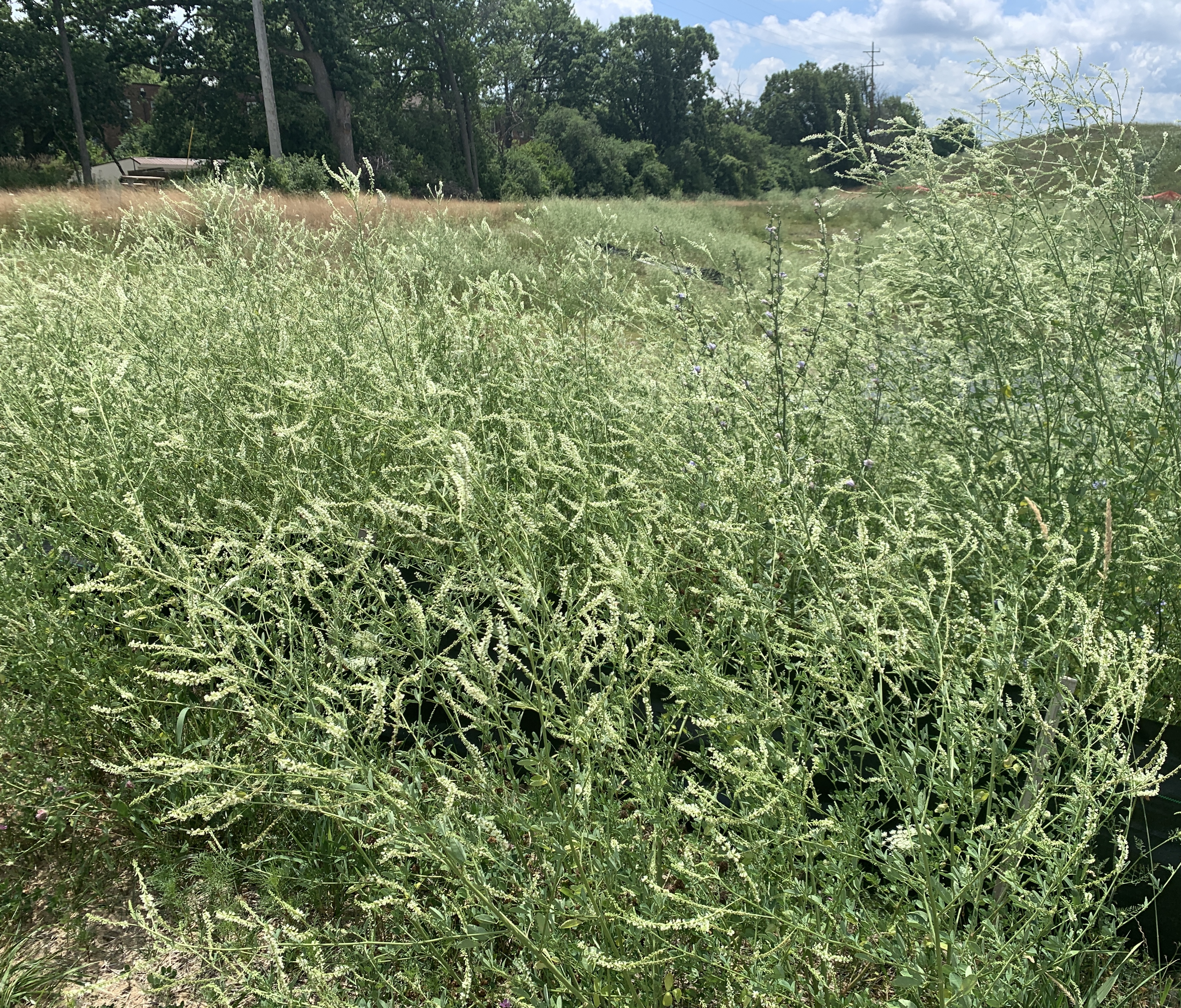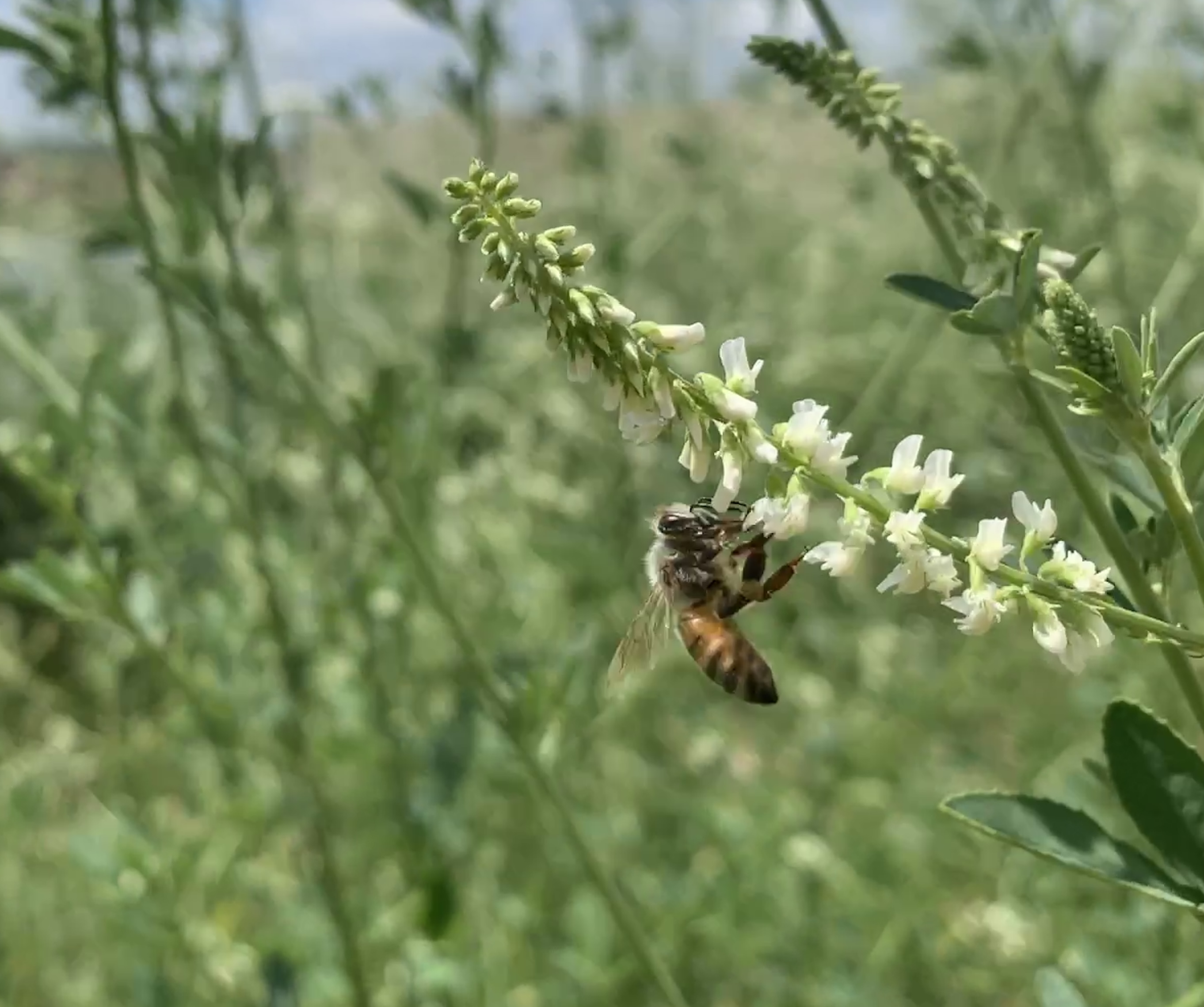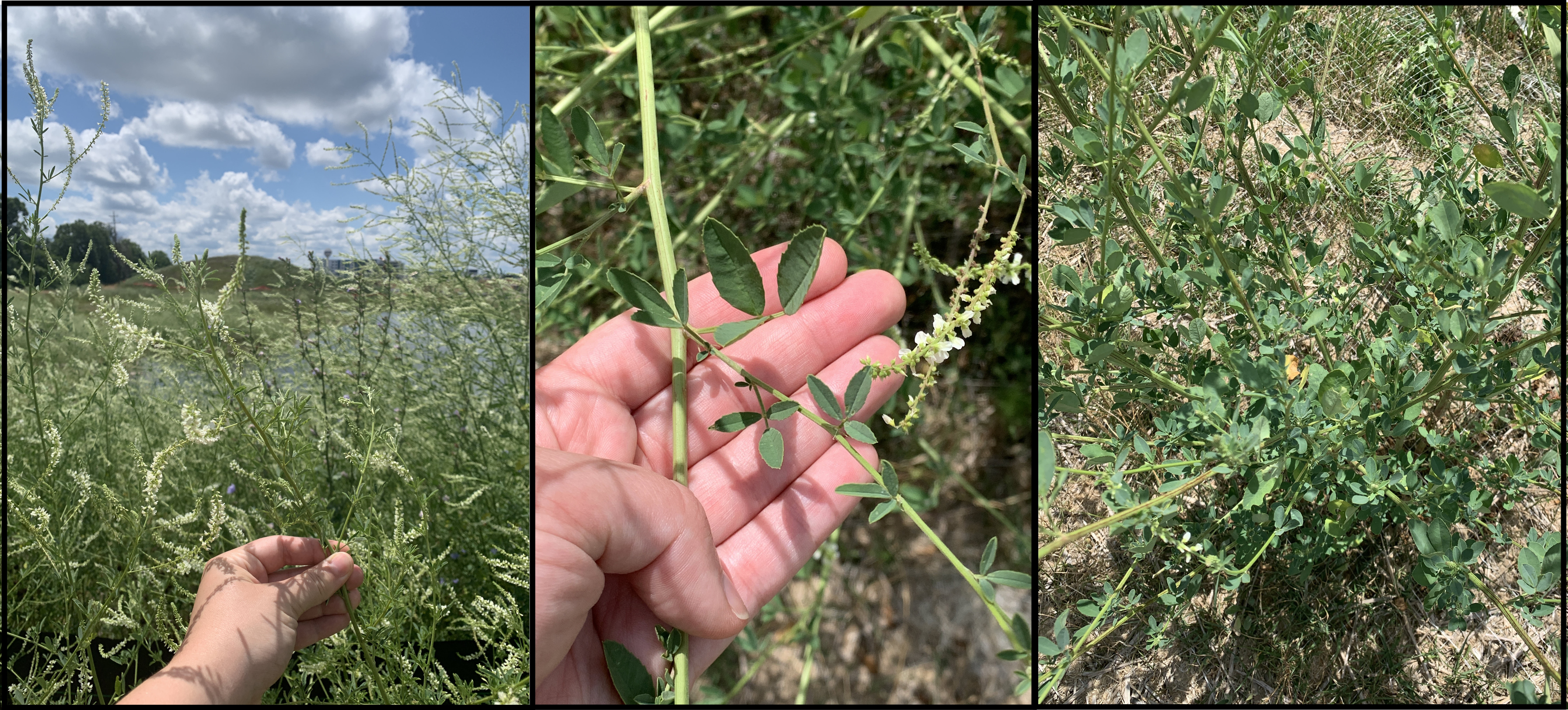Drive-by botany: Orange daylily and white sweet-clover
Profiles of common Michigan roadside flora in early July 2022.

Authors’ note: Drive-by Botany is a continuing series that highlights flowering plants commonly seen from the road. As a service to new readers, we include the introduction with each article. If you're already familiar with the premise, feel free to skip down to the good stuff.
Has a patch of flowers ever caught your eye as you travelled down the road? It certainly happens to us all the time! As gardeners and naturalists, we're always interested increasing functional diversity in our gardens and landscapes, so we thought it would be fun to consider some of the roadside plants that we see every day. Each article in this series will feature two plant species that are currently blooming and frequently observed from the road. Our goal is to answer two simple questions:
- What are they?
- Would they make good garden plants?
As part of the process, we'll include some biological tidbits and a few useful characteristics for identification. Please note that some of the plants we feature are exotic invasive species; we'll be sure to include recommendations from land management professionals on how to manage them in your landscape.
July 2022 - week 28, growing degree days (GDD) 2,735 base 32 F, East Lansing, Michigan
Orange daylily (Hemerocallis fulva)
Synonyms: ditch lily, tawny daylily, Fourth of July lily, outhouse lily, roadside lily, etc.)
The orange daylily is an herbaceous clump-forming perennial that spreads predominately through stolons and tuberous roots. It is a member of the Asphodelaceae, a diverse group of approximately 900 plant species with relatively few shared characteristics. Hemerocallis fulva is not considered a true lily, a term used exclusively for plants in the genus Lilium, but is often mistaken for one due to the remarkable similarity of the flowers.
Author's note: An easy way to tell the difference between daylilies and true lilies is to look at the leaves and the flowering stalks. The leaves of true lilies are arranged around the flowering stem in whorls. Daylilies have a bunch of long narrow leaves that grow from the crown of the plant (where the plant emerges from the soil) and form clumps. There are no leaves on the flowering stalks of daylilies.
Description
Flowers: From a roadside perspective, the flowers of H. fulva are unmistakable: they're large, orange, and flare out like the bell of a trumpet (Photo 1). No other plant with flowers of similar color, size, and shape grows so freely and abundantly along our Michigan roads. Each plant can produce upwards of 10-20 blossoms at the apex of a central leafless stalk in a special type of inflorescence called a corymb (Photo 2). This arrangement isn't immediately obvious because the flowers open in succession and only bloom for one day (hence the common name "daylily"). Each blossom has six orange-red tepals, each with a single creamy-white center line, that shift to a vivid yellow color at the center of the flower.
Quick definitions: A corymb is a special type of inflorescence in which the pedicels (stalks) of the lower flowers are longer than the pedicels of the upper flowers. This arrangement results in an inflorescence that is more-or-less flat across the top (as opposed to something that is more dome-shaped). The term tepal is used when the sepals and petals of a flower are similar in color, size, and shape.
Leaves: Long and narrow leaves arch from a central clump, giving the plant a mounded look. They are typical daylily in shape, looking similar to grass, only much wider and longer than our typical turf grass species. Orange daylily leaves are bright green (sometimes with a yellowish tint) and can be anywhere from 1 to 3 feet long and 0.5 to 1.25 inches wide (Photo 2).
Seeds/Fruit: When fertilized, daylilies produce a capsule that dries and splits open at maturity to release the seeds within. However, it is widely assumed that most of the orange daylilies we see along the road are sterile and reproduce vegetatively by stolons and tuberous roots. The likelihood of finding a seed capsule within a roadside population is, therefore, relatively low.
Size: Plant height is determined by the flowering stem (called a “scape” in this instance) which can be as much as 5 feet tall. In the absence of the stem, the foliar mound is often 2-3 feet tall.

Distribution: The orange daylily has demonstrated superior adaptability to a wide range of habitats, including those with poor soils, and seems to grow vigorously wherever it is planted. We see it most often along roadsides and ditches, woodland edges (Photo 2), fields, railroad tracks, and (of course) home landscapes. Daylilies do require some sunlight, so it is uncommon to find them thriving in full shade locations. H. fulva is currently documented in 37 Michigan counties, but as expressed in Michigan Flora, is “much more widely established in southern Michigan than collections would suggest."
Blooming period: We typically see orange daylilies start to bloom in late June or early July and sometimes continue through August.
Native status: Exotic/Introduced. This species is not native to the United States. It is native to Asia was first documented in Michigan in Jackson County in 1870.
Garden uses: H. fulva was brought to the United States for ornamental purposes and has been used in that capacity since the nineteenth century. It's a tough, long-lived perennial that is easy to establish and maintain. The tall bold blooms and the pleasing foliar architecture of the orange daylily can bring lively contrast and attractive texture to perennial borders. Individual clumps can serve as focal specimens and mass plantings can crowd out weeds or even serve as a ground cover. Moreover, its ability to thrive in dry and nutrient-poor environments makes it an interesting candidate for erosion control on slopes and reclamation projects.
The positive qualities, however, do not come without concessions. As a vigorous and occasionally aggressive exotic species, H. fulva has the ability to invade ecosystems by quickly forming dense colonies through vegetative reproduction (Photo 2). Because of the aggressive tendencies, some municipalities in Michigan list it as an invasive species, as do five states in the eastern U.S. That being said, it has certainly become naturalized throughout the mid-Atlantic and North Central United States and probably all of Michigan's lower peninsula. One can hardly drive down a road in early July without seeing the pretty orange blooms.
So how do we balance local ecological concerns with the fact that it seems to be everywhere in lower Michigan? We recommend a case-by-case evaluation before establishing a new planting. Usage in highly developed urban areas is unlikely to have notable ecological ramifications. We would, however, suggest careful consideration before planting it near woodlands and high-quality natural areas.
Common look-alikes: Michigan lily (Lilium michiganense), tiger lily (Lilium lancifolium), wood lily (Lilium philadelphicum)
White sweet-clover (Melilotus albus)
White sweet-clover can be seen growing in large swaths along roadsides throughout Michigan. It is a widespread species throughout the United States and was introduced for soil improvement and forage, and it is highly attractive to bees. This species has a nearly identical relative, yellow sweet-clover (Melilotus officinalis), which can be told apart by the yellow flowers. Both sweet-clovers are commonly biennials in Michigan. In the first year, there is a single stem with many branches. In the second year, plants are larger, flower and produce seeds.
Sweet-clover species have deep tap roots that take up nutrients from the soil and help stabilize eroding slopes. However, they have a high capacity for reproduction (via seed) which has made them an aggressive species in the Midwest. They are often found growing in disturbed sites but have the capacity to displace native species when found in important sunny, open habitats such as prairies. They also have a distinctly sweet smell, which comes from the chemical coumarin.

Description
Flowers: The inflorescence of white sweet-clover is a spike with many small, white flowers. The inflorescence can be up to 8 inches in length. Individual flowers have a similar shape to pea flowers, as it is also a member of the Fabaceae, or legume, family.

Leaves: The leaves are compound and arranged in groups of three leaflets. The leaflets are usually 0.5 to 1 inch long and have a rounded tip and small teeth along the margin.
Stems: White sweet-clover has smooth, green stems that are sometimes grooved. They are often hollow inside. Near the base of the plant, stems may become somewhat spreading with a denser leaf canopy.
Seeds/Fruit: Fruit ripen in August and are small, wrinkled pods. Each pod contains one to two seeds. Sweet-clover produces both seeds that are ready for immediate germination and “hard” seeds that require scarification or a disturbance event (fire, digging, etc.) to germinate. These seeds can remain viable for 30 years or more and allow the plant to create a soil seed bank at sites.
Quick definition: Scarification is when the seed coat is weakened, which encourages germination. This can be done through mechanical, thermal, or chemical means naturally in the landscape or by humans that wish to speed up the germination process. The weakening of the seed coat allows water and air to enter, which are crucial elements for germination.

Distribution: White sweet-clover can be found in all 50 states in the U.S. In Michigan, it has thoroughly naturalized. According to Michigan Flora, it has been collected in all but 10 counties.
Blooming period: White sweet-clover blooms in Michigan from June through August.
Native status: Exotic/Introduced. This species is not native to the United States. It is thought to have been established in Michigan by at least 1860.
Garden uses: White sweet-clover was introduced and spread for agricultural reasons such as building soil and forage, and not so much small-scale gardening purposes. Similar to other legumes, white sweet-clover is able to fix a moderate amount of nitrogen and helps build the soil. There is also a high amount of biomass that can be incorporated, and the root system anchors the soil profile. Due to this, both white and yellow sweet-clover have been used as cover crops and to stabilize agricultural fields. Proper timing of termination is important to prevent escape from cultivation. Sweet-clovers are also a popular forage plant for bees and butterflies during summer (nectar).
Despite some situational-dependent usefulness, adding them to the garden is not recommended. These Melilotus species can be aggressive due to high seed production and have invasive tendencies. White sweet-clover produces more seeds (200,000 to 350,000) than yellow sweet-clover (more than 100,000). Sweet-clovers have the potential to displace native species in high value habitats and can have negative impacts when encroaching on grasslands or riparian areas where they can compete well. They do not do well in shady locations. These plants are most often found in disturbed sites, such as along roadsides, where management may not be a top priority. For smaller infestations, hand pulling the first year or the second year before they flower is a good management strategy.
Common look-alikes: Non-flowering plants or seedlings may look like alfalfa (Medicago spp.), but alfalfa has hairs on the underside of leaves and purple flowers.
Want more Drive-by Botany? Check out some of our other roadside adventures!
Questions? Feel free to contact Jeremy Jubenville or Isabel Branstrom with the MSU Extension landscape team.
Thank you to Tyler Bassett from the Michigan Natural Features Inventory for his review of this article.
Resources:
- Michigan Flora (2001) – E. Voss
- USDA PLANTS Database - Hemerocallis fulva
- Invasive Plant Atlas of the United States (developed by the University of Georgia - Center for Invasive Species and Ecosystem Health)



 Print
Print Email
Email










